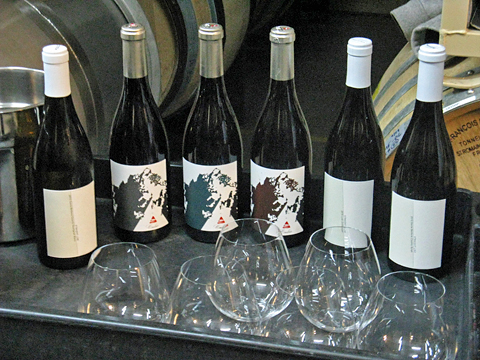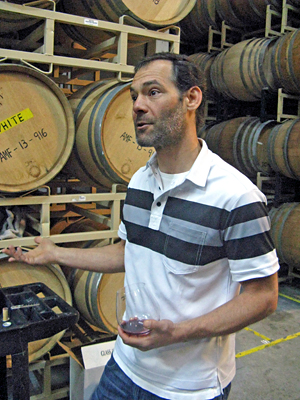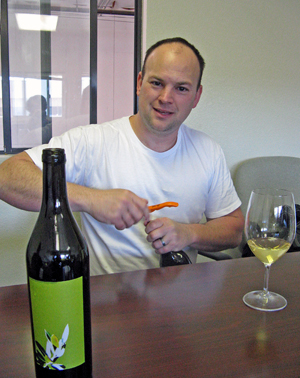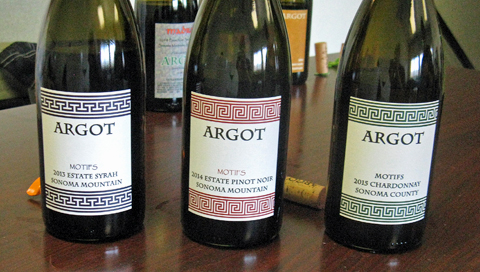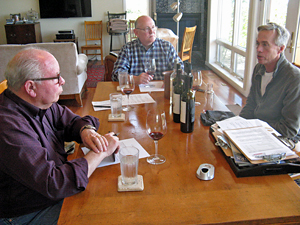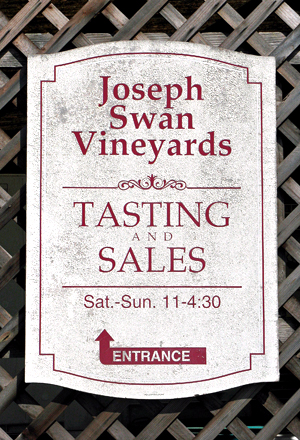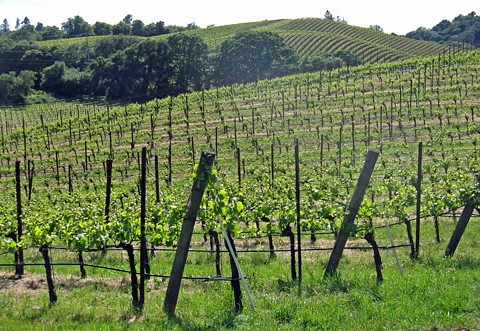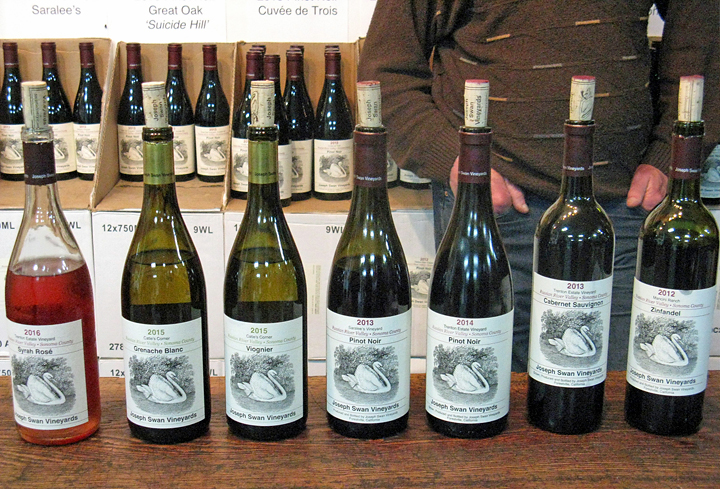Sonoma County Tour - April 2017 - Part 3
Eric, Michael, and I had a pretty relaxing pace on the first two days of our three-day wine tour, with just two winery stops each day (though one of those was a “two-fer” winery visit), but the final day would be busier, with four visits. We figured our Thursday schedule wouldn’t be too hectic, though, since our first two appointments of the day were both at the same facility in Santa Rosa. Since I would be driving back home after dinner in the evening, we drove separately to our first wine visit of the day.
| Thursday
- April 27, 2017 |
Couloir Wines / Straight Line Wine
Tasting Notes: Current & Recent Releases & Library Wine |
Straight Line 2015 Sauvignon Blanc, Santa Barbara County. Citrus and slightly tropical fruit aromas along with herb, oak, and spice notes. Medium-bodied with a richer texture than most Sauvignon Blancs.
Couloir 2014 Pinot Noir, Monument Tree Vineyard, Anderson Valley. Forest floor, earth, and herbs are upfront, with black cherry, spice, and a touch of sweet oak in support. Medium weight with good acidity and a bright, lively finish, nice.
Couloir 2014 Pinot Noir, Chileno Valley Vineyard, Marin. This featured a more savory character, with earth, tea leaf, black cherry and plum fruit, and a touch of spice. Medium-bodied with a nice texture and refined tannins on the finish – my favorite of the three Couloir Pinots.
Couloir 2014 Pinot Noir, John Sebastiano Vineyard, Sta. Rita Hills. Riper and somewhat darker fruit profile, with bigger spice and earth components. This was bigger on the palate as well, the most structured of the three Pinots, finishing with moderate tannins.
Straight Line 2015 Zinfandel, Lodi. Ripe dark berry fruit and spice, with herbal undertones. Moderately rich mouthfeel, this had an almost “Rhônish” character to it – this could use another year or two to develop further in the bottle.
Straight Line 2010 Syrah, Santa Barbara County. Very savory aromatics, with olive and herb in addition to black fruits, spice, and vanilla/oak. Medium-full bodied with good structure, this should continue to age nicely for at least another five years.
|
|
We began our Thursday with a short drive to the Vinify Wine Services custom crush facility in Santa Rosa. It’s a much larger place than Healdsburg Custom Crush, which we’d visited the previous day. Eric and I had been to Vinify in 2012, tasting there with vintner Russell Bevan – Russell still makes his wine there, along with quite a few other highly-regarded producers. On this day we were meeting Jon Grant of Couloir Wines and Straight Line Wine. I first tasted Jon’s wines in 2011 at the annual Marin County Wine Celebration, where he poured his Pinot Noir made from Marin fruit. I’ve tried his wines at that event in the years since and at the Anderson Valley Pinot Noir Festival as well, and always liked them, so I thought it was time for a more in-depth visit with Jon.
Unlike the previous two days, Thursday started out bright and sunny, and as I was the first of our group to arrive at Vinify, I was able to enjoy a few minutes out in the sun before everyone else arrived. Before long, Eric and Michael pulled into a parking spot just as Jon walked up to say hello. We followed Jon into the facility, where he gave us a brief overview of the operation at Vinify before leading us into one of the barrel rooms to taste his wine.
Jon told us he learned about wine while he was working in the beverage department at Snowbird Ski Resort in Utah – Jon loves skiing, and had just been to the mountains the previous day. Jon has credited Snowbird’s beverage director, Vicky Martinez, for opening his eyes to the world of fine wine. Before long, Jon was making visits to Napa to taste wine there and he ultimately decided to move there and enter the wine industry. He started out as a tour guide at Robert Mondavi Winery, where they offered him the opportunity for broader wine education in viticulture and enology, which Jon supplemented with studies at UC Davis. He had subsequent stints at Corison Winery and then back at Mondavi, and he also worked with consulting winemaker Nils Venge at PlumpJack Winery during the 2000 crush season. In early 2001 Jon began working at Turley Wine Cellars, where he spent about 10 years working with winemaker Ehren Jordan. He enjoyed working with Ehren, who encouraged employees to find their own path and develop their strengths. Jon told us that one of Ehren’s sayings was that you would either sink or swim at the winery and he wasn’t a swim coach!
Jon established Grant Family Wines in 2007, and he has two labels – Couloir Wines and Straight Line Wine. The initial 2007 vintage included two Pinot Noirs, a Syrah, and a Tempranillo. The names of both labels come from ski references – a couloir is a steep, narrow gully that can be skied when it’s filled with snow, and a straight line…well, that’s the fastest route! Straight Line is for varietal- and appellation-designated wines, while Couloir focuses on single-vineyard Pinot Noir. The Couloir Pinots are all sourced from cool-climate regions – Anderson Valley, the Sonoma Coast, Marin County, and the Santa Rita Hills. Jon has a tasting room for his wines in Tiburon, in Marin County – he told us that he likes the location as it has good access for his customer base. An added bonus is that the building where his tasting room is located was the site of Rodney Strong’s first winery in 1960, Tiburon Vintners, which later relocated and became Windsor Vineyards. Jon noted that the building still has the original tasting bar.
While we tasted Jon’s wines, he told us about his winemaking. His picking decisions are based mainly on pH and on the physical condition of berries, stems, and vines, rather than on brix of the fruit – though with his cooler-climate sources for Pinot, this means that brix is moderate, resulting in alcohol in the 13-14% range. Once the fruit is in the winery, Jon keeps it in the cold room there for 24 hours. He told us that this allows time for him to think more about winemaking decisions, and also helps to heal stem cuts to keep green sappy flavors out of the wine. Jon said that he’s a fan of the Northern Rhône’s Alain Graillot, who uses 100% stem inclusion in his wines even though the stems may be all green. Jon likes to ferment using a good deal of whole clusters with whole berries for his Pinots, typically 33-50%. He noted that the partial carbonic character gained from this, with a good deal of dissolved CO2 in the wine, helps provide freshness and ageability. Fermentations are not inoculated, and Jon prefers to ferment in smaller stainless steel tanks with heating / cooling jackets. All the wines are from relatively small lots of fruit, five tons and under – Jon noted that three-ton lots are his favorite to work with. Jon has moved away from new barrels in the past couple of years, and there’s no cold stabilization on whites – keeping things simple in the winery.
We started our tasting with the 2015 Straight Line Sauvignon Blanc. The fruit was sourced from McGinley Vineyard in Santa Barbara County’s Happy Canyon, and the vineyard is managed by Jeff Newton’s highly-regarded Coastal Vineyard Care. The vines are at the base of a slope with gravel and clay soil. The fruit was whole-cluster pressed and settled in tank, then racked to neutral oak. Jon did some lees-stirring in barrel, and the wine did not go through malolactic fermentation.
We continued with three 2014 Couloir Pinot Noirs, beginning with the Monument Tree Vineyard bottling from Anderson Valley. Jon has made a Pinot from this site since his initial vintage in 2007, getting fruit from the same 12 vine rows – 3 Pinot clones with 4 rows each. The vineyard was planted in 1999 for Duckhorn’s Goldeneye project, and it’s farmed by Ardzrooni Vineyard Management. The fruit was fermented with 50% whole clusters and aged in 35% new French oak. Next was the Pinot from Chileno Valley Vineyard in northern Marin County, managed by Mark Pasternak, who farms a number of Marin vineyards – this is another wine that Jon has made for a number of years, and the first of his wines that came to my attention. This underwent 25% whole-cluster fermentation and was aged in 15% new French oak. The last Couloir Pinot bottling we tasted was from John Sebastiano Vineyard on the eastern edge of the Santa Rita Hills – Jon’s first vintage from this site was in 2012. The vines are farmed by Coastal Vineyard Care, and Jon noted that it’s a windy site, with small berries on the grape clusters. This Pinot was fermented with 35% whole clusters and was aged in 35% new French oak. All three Pinot Noirs were very distinctive, with good typicity of their respective regions, and all have the structure for aging.
Two more Straight Line wines followed the three Pinots. The 2015 Zinfandel was sourced from Kirschenmann Vineyard in Lodi, owned and farmed by Turley’s Tegan Passalacqua. The vineyard is in an oxbow of the Mokelumne River, with sandy decomposed granite soil. It’s actually an old field blend, mainly Zinfandel plus a little Carignane and Mondeuse. Jon had pulled out a library wine for our last wine of the tasting – a 2010 Syrah from McGinley Vineyard in Happy Canyon. It was fermented entirely with whole clusters and co-fermented with 3-4% Viognier, then aged in barriques plus a 500-liter puncheon.
In addition to the wines we tasted, Jon makes a Couloir Pinot Noir from Campbell Ranch in the Annapolis region of the Sonoma Coast, as well as Straight Line Chardonnay, Pinot Noir, and Tempranillo.
Our visit with Jon was a nice start to the last day of our three-day wine tour, and he poured us a very good group of wines. I thought the three 2014 Couloir Pinot Noirs were particular standouts – of the three, my favorite was the Chileno Valley Vineyard bottling, with the Monument Tree Vineyard just behind. I liked the Straight Line 2015 Zinfandel too – it’s not a shy wine but not a fruit bomb either, nicely balanced. And the Straight Line 2010 Syrah library wine showed how well Jon’s wines can develop in the bottle.
I’ve enjoyed talking with Jon from the first time I met him. He’s very engaging, and he can give you all sorts of details about his winemaking and his wines without it seeming like it’s just minutiae – he’ll take the time to explain why he does things the way he does. He told us that he wants to produce wines with great mouthfeel and texture in addition to aromatics – keeping wines fresh and not heavy – and I think his wines show that he’s succeeded in that. The Couloir / Straight Line tasting room in Tiburon would be a good stop for anyone who’s looking for this type of wine. Jon mentioned to us during our visit that making wine takes the “right grape, right vineyard, right people” – I’d say he’s done a fine job of finding that combination.
Argot Wines
Tasting Notes: Current & Recent Releases |
Argot “Motifs” 2015 Chardonnay, Sonoma County. Bright and fresh citrus and apple aromas, with herb and earth undertones. Medium-bodied, with a slightly chalky mineral texture and finish, nice.
Argot 2013 Chardonnay, Simpatico Ranch, Bennett Valley. Pear and citrus on the nose along with earthy, savory, and stony mineral notes. Medium weight combined with zippy acidity, with a lively texture and long finish, very impressive.
Argot 2014 Chardonnay, Simpatico Ranch, Bennett Valley. This showed a more lemon/citrus character than the 2013 vintage, along with earth and fresh herb aromas. Medium-bodied but a bit brighter on the palate, with a stony mineral quality on the finish – good potential and should develop with a bit more time in the cellar.
Argot 2013 Pinot Noir, “Madras,” Steiner Vineyard, Sonoma Mountain. Savory and spicy, with ripe red fruits and touches of earth and oak in the background. Medium-bodied with good structure and moderately chalky tannins on the finish.
Argot 2014 Pinot Noir, “Madras,” Steiner Vineyard, Sonoma Mountain. Red fruits, spice, and a stony mineral quality plus savory and herbal aromas. Fine acidity and a lively texture, with moderate but refined tannins and a long finish – showing a bit more focused than the 2013, this should have very good aging potential.
Argot “Motifs” 2014 Pinot Noir, Estate, Sonoma Mountain. More upfront fruit than the previous two Pinots, with black cherry, tea leaf, and earth on the nose. A bit bigger mouthfeel with broader texture and tannins – still young, this should develop well with more time.
Argot 2014 Pinot Noir, Saralee’s Vineyard, Russian River Valley. Slightly darker color, this featured plenty of cherry and plum fruit, spice, and touches of earth and stony minerals. Somewhat richer mouthfeel, finishing with more pronounced tannins than the earlier Pinots.
Argot “Motifs” 2013 Syrah, Estate, Sonoma Mountain. Dark fruit, savory and spicy, with vanilla/oak and smoke aromas in support. Big and structured on the palate, with grippy tannins on the finish – more time in the bottle should benefit this wine.
|
|
Our next appointment was conveniently in the same facility, Vinify Wine Services in Santa Rosa. Justin Harmon of Argot Wines had come in and said hello as we were nearing the end of our earlier tasting, and when we were finished, we followed Justin upstairs to a meeting room and sat around the small conference table there. I’d met Justin and tried some of his wines 5-6 years ago at a couple of larger tasting events, and I’d wanted to visit him in the past but we had not been able to coordinate a time to do that before.
While Justin started opening up some bottles for us, he told us about himself. He grew up in Chicago and has a background in chemical engineering and software programming. Justin first tried his hand at winemaking in his Chicago basement, from frozen grapes shipped from Peter Brehm in California. He told us that he was unprepared for how much CO2 even that small batch of fermenting grapes could put out! He said his interest in wine was partially sparked by internet resources such as the West Coast Wine Network discussion forums and the GrapeRadio podcasts (Eric Anderson is one of the key members of GrapeRadio in addition to Grape-Nutz).
One of the early stars of internet wine discussion groups was Russell Bevan, who became well-known posting under the name “Bacchus” and leading now-legendary wine tours in California. By the mid-2000s, Russell had moved to California wine country and had started making wine, and he’d put out word on the internet that he was looking for help to sort grapes during the 2006 harvest. Justin responded to Russell and worked with him during that year’s crush. Justin credits Russell for encouraging him to make wine himself. It didn’t take Justin long to jump right into winemaking, and the first Argot wine was a Syrah in 2007. He added Chardonnay to his list of grape varieties in 2008 and Pinot in 2009. Justin left his day job to focus on Argot in 2011, while he’s also the consulting winemaker for a couple of other producers including Belden Barns. Current annual production for Argot is about 2,000-2,400 cases.
Justin began our tasting with a 2015 Chardonnay from Argot’s Motifs line of wines. The Motifs line was started in 2016, and the wines are meant for wider distribution and more exposure than the smaller-production Argot bottlings, but Justin noted that they’re not “entry-level” wines. Sourced from cool Bennett Valley and picked at about 23 brix with lower pH, the Chardonnay fruit for this wine was barrel-fermented in once-used French oak, and went through full malolactic fermentation.
Justin said that from a wine consumer standpoint, “his heart is in Syrah, but his mistress is Chardonnay.” It was easy to see how that translated to his own wines with the two Chardonnays he poured us next, 2013 and 2014 vintages from Simpatico Ranch, located adjacent to Matanzas Creek Vineyard in Bennett Valley. One of Sonoma County’s coldest sites for Chardonnay, Simpatico Ranch has 40 year-old Old Wente clone vines planted in volcanic soil, and Justin has made Chardonnay from there since 2009. Fruit for both vintages was whole-cluster pressed direct to barrel, where Justin did some lees-stirring. No SO2 was added while the wine was in barrel, 13 months for the 2013 vintage and 16 for 2014. Both wines were racked to stainless steel tanks from barrel to age for another few months prior to bottling – Justin feels that gives the wines a more complex texture. He told us that these Chardonnays are inspired by the wines of Meursault, and that the Simpatico Chard is his favorite wine to make. Though each vintage was distinct from one another, both were outstanding.
After comparing the two Argot Chardonnays from Simpatico Ranch, we did the same with two Pinot Noirs from Steiner Vineyard on the west side of Sonoma Mountain, also from the 2013 and 2014 vintages. Steiner – the estate vineyard of Belden Barns – is a small site that was first planted by David Steiner in 1973. At about 1,000-foot elevation, it’s exposed to the Petaluma Gap to the west, where cool marine air and fog is funneled through low spots in the coastal hills. The vines there are on decomposed volcanic soil, clay loam, sandy loam, and rock cobble. Due to phylloxera, Nate and Lauren Belden had to replant the vineyard, and the new Pinot vines began producing fruit by 2011. Noted vineyard manager Chris Bowland farms the fruit there. The Pinot is planted in a “massale” style with 10 Pinot clones and selections in a repeating pattern – the patchwork nature of the planting led to the distinctive label design and the “Madras” name for the Argot Pinots from Steiner Vineyard. The fruit was fermented with whole clusters – Justin likes the complexity from the stems and the carbonic element that gives the wines – and aged in 5-7 year old oak, with the 2014 vintage in barrel for about six months longer than the 2013.
We continued with the 2014 Argot Motifs Pinot Noir. The fruit comes from their estate vineyard, which is owned by Justin’s business partners and is located directly next to Steiner Vineyard on Sonoma Mountain. Justin planted a total of 5½ acres there, with 1 acre of Chardonnay, 2½ acres of Pinot Noir, and 2 acres of Syrah. The Pinot includes five California Heritage selections including Beba, Rochioli, and Calera. The fruit for this wine was entirely destemmed, and aged for nine months in once-used French oak. Justin poured us one more 2014 Pinot Noir, from Saralee’s Vineyard in Russian River Valley. The wine is from 50% each of two very different Pinot clones, Wädenswil 2A and Jackson 9, planted at Saralee’s in 1988. The Wädenswil clone came to the US from Switzerland in the 1950s, while the Jackson clone can be traced to an experimental vineyard planting in Amador County by UC Berkeley professor Eugene Hilgard in the 1880s. The wine was aged for 17 months in 50% new French oak.
Justin finished up our tasting with his 2013 Argot Motifs Syrah, from the estate vineyard on Sonoma Mountain. From Alban 1 and 877 Syrah clones, this was fermented with 25% whole clusters and spent 18 months in 50% new French oak – about 12 months shorter barrel aging than most Argot Syrahs. Justin told us that he loves the Syrahs of Alban Vineyards, and that those are the inspiration for this wine.
I was glad that I finally had the opportunity to get together with Justin and taste his wines. In the years since I last tried the Argot wines, it’s clear that Justin has really honed his craft, and I was impressed by his latest bottlings. All of the three Chardonnays were standouts, with the 2013 Simpatico Ranch bottling being my favorite. The 2014 “Madras” Pinot Noir and 2014 Motifs Estate Pinot were terrific as well.
In talking with Justin, I get the sense that he takes great enjoyment from what he’s doing. His passion and enthusiasm really show through when he’s discussing his wines. Justin has chosen an interesting term for his wine label – the word “argot” is defined as a sort of secret language that’s used to prevent outsiders from understanding their conversations, though it can also refer to the specialized vocabulary used in a particular field…such as winemaking. There’s nothing secretive or mysterious about Justin’s wines, though – they will appeal to a wide range of wine lovers and they’re well worth checking out.
Both of our Thursday morning visits had run longer than expected, and with limited time until our first afternoon appointment, we reluctantly decided to skip lunch. Eric and Michael did have some things to snack on in their car, and we soon headed out from the Vinify parking lot and drove just a few miles north to Windsor, where we turned east toward our first afternoon destination.
Calluna Vineyards
Tasting Notes: Current Releases & Pre-Release Wines |
Calluna 2016 “Estate Blanc,” Chalk Hill. 60% Sauvignon Blanc, 40% Sémillon. Beautiful aromatics featuring pear and citrus fruit with touches of fresh herbs, flowers, and spice. Medium-bodied with a lively texture and finish, nice.
Calluna 2014 “Calluna Vineyard Cuvée,” Chalk Hill. 47% Merlot, 26% Cabernet Sauvignon, 10% Cabernet Franc, 9% Malbec, 8% Petit Verdot. Bright but subtle aromas of plum, black cherry, herbs, earth, and savory undertones. Medium weight with good acidity and a stony mineral note on the finish, nice.
Calluna 2011 “Calluna Estate,” Chalk Hill. 44% Cabernet Sauvignon, 26% Merlot, 19% Cabernet Franc, 7% Petit Verdot, 4% Malbec. More upfront herbs on the nose, with black cherry fruit, earth, and a touch of oak. A bit richer and more structured on the palate, with moderately grippy tannins.
Calluna 2013 “Calluna Estate,” Chalk Hill. 49% Cabernet Sauvignon, 27% Merlot, 14% Cabernet Franc, 8% Petit Verdot, 2% Malbec. This displayed more intense and darker fruit than the 2011 vintage, plus a more savory character along with spice and oak in support. Medium-full bodied with a bigger tannic finish – lots of promise and this should have a long life ahead of it.
Calluna 2012 “Calluna Estate,” Chalk Hill. 59% Cabernet Sauvignon, 25% Merlot, 7% Cabernet Franc, 5% Petit Verdot, 4% Malbec. The 2012 vintage showed more tobacco and dried herb aromas, with currant and darker fruit, earth, and a stony mineral component. Fairly rich but lively on the palate, finishing with firm tannins – approachable already but should age nicely too.
Calluna 2014 “The Colonel’s Vineyard,” Chalk Hill (pre-release). 100% Cabernet Sauvignon. Darker and more upfront fruit, along with a bigger vanilla/oak component, along with touches of spice and dried herbs. Richer mouthfeel with broad, somewhat chewy tannins on the finish – a bigger wine for Calluna but not overdone.
|
|
Since I knew that Eric and Michael were fans of wines made from Bordeaux grape varieties, I thought a visit to Calluna Vineyards would be a good idea, and I was able to arrange an appointment with Calluna’s David Jeffrey on Thursday afternoon. I’d visited David back in 2012 and thought then that he was making some of the best Bordeaux-style wines I’d tasted from Sonoma County. We had no trouble following David’s directions to his estate vineyard, located in the Chalk Hill area of Sonoma County, east of Windsor. After turning off a small road in the countryside, we crossed a creek and continued up through the green hills until we reached David’s hilltop house. We parked, and David’s friendly dog, Molly, was out to greet us right away. David was out a moment later to welcome us, and we followed him through the house to the back patio, where he gave us an overview of the vineyard.
Like many in the wine business, this is not David’s first career. He’s originally from the East Coast, and he had worked in finance for Seagram’s in New York City. Although he was not involved in their wine division, he was able to take a fairly comprehensive wine appreciation course through the company and that sparked his interest. By the mid-1980s, he had developed a particular love for the wines of Bordeaux. With wine becoming an ever-increasing interest, he and his family moved to California in 2001, and he enrolled in the enology department at Fresno State University. While he was studying there, he took time off to work in Bordeaux during the 2003 harvest for Château Quinault in Saint-Emilion. He worked there with noted French vintner Dr. Alain Raynaud, learning both traditional and new techniques that he would later put into practice at Calluna.
During his studies, David and his wife Marla had been looking for property where they could plant a vineyard. David told us that the Chalk Hill region intrigued him since it’s a transitional area between the cooler parts of Russian River Valley to the west and the warmer Alexander and Napa valleys to the east – it’s warm enough in Chalk Hill to ripen Bordeaux varieties but not too hot. David was fortunate enough to find the 80-acre property on Chalk Hill in 2004, right when it went on the market. Although it was larger than he and Marla had planned on buying, he was able to raise money from family and friends to buy the property and start the wine venture. After extensive soil testing and permitting, David began planting the site in 2005. He and his family moved there the following year and the first harvest from the vines was in 2007. The hillsides were mostly grassland and may have been used for grazing at one time, so the site was well-suited for putting in a vineyard.
The Calluna estate vineyard is in a higher-elevation spot that is exposed to cooler ocean air but above the fogline. The initial planting in 2005 was 12 acres, with four Cabernet Sauvignon blocks, plus Merlot, Cabernet Franc, Malbec, and Petit Verdot. David planted another five acres in 2013, including some Sauvignon Blanc and Sémillon, and that newer planting had its first commercial crop in 2016. David works with a vineyard manager but oversees the farming himself. Vines are planted in various blocks on the hillside site, which combines good drainage with various exposures and slopes. There is about 18-24 inches of loamy clay topsoil throughout most of the site, with fractured shale and sandstone below. Two vineyard blocks deserve special notice, since they have particular significance for two of the Calluna wines. The best one-acre block of Merlot is named in honor of Dr. Alain Raynaud and his family. Planted to Merlot clone 181, this goes into the Calluna “Aux Raynauds” Merlot. The Colonel’s Vineyard is a 1¼-acre block on a gentle southwest slope near the top of the hill, just below the house. This block is planted to Cabernet Sauvignon clone 337 and goes into Calluna’s “The Colonel’s Vineyard” Cabernet.
The Calluna wines currently include the newly-released Sauvignon Blanc / Sémillon “Estate Blanc” blend, two Merlot-based blends (“Calluna Vineyards Cuvée” and “Aux Raynauds”), a Cabernet Sauvignon-based blend (“Calluna Estate”), a 100% Cabernet Sauvignon wine (“The Colonel’s Vineyard”), and a limited-production 100% Malbec bottling. All of the wines are made entirely from estate fruit, and all of the vineyard’s fruit goes into the Calluna wines – none is sold to other vintners. The wines are produced at Vinify Wine Services in Santa Rosa, and total annual production is about 2,500 cases – David hopes this will increase to around 4,000 cases as the newer estate plantings begin to produce more fruit. A note about the winery name – David had wanted it to have something to do with “heather,” as that was the name of a family friend who had passed away. It turned out that everything with heather in the name had already been trademarked, but David and Marla spotted a heather plant in a nursery that was labeled “calluna” – the botanical name for the plant – and they thought that name was perfect. The elegantly-designed Calluna wine labels feature a drawing of a heather plant.
After taking a look at the vineyard from the patio, we headed back into the house and took seats at the dining table, where David had set out four of his wines for us to taste. We started with the recently-bottled 2016 “Estate Blanc,” a blend of 60% Sauvignon Blanc and 40% Sémillon. Picked early with lower pH, the fruit was fermented and aged in neutral oak, finishing at less than 13% alcohol. This initial release is about 125 cases, and David hopes there will be enough fruit as the vines mature to grow this bottling to about 500 cases.
Our first red was the 2014 “Calluna Vineyard Cuvée” – it’s the label’s largest-production wine, and always the first of the Calluna reds to be released each vintage. It’s always Merlot-based and this vintage was aged in about 20% new French oak. David told us that he does not make water or acid additions to his wines, and the reds average around 14% alcohol. They typically spend 21-22 months in barrel, with the percentage of new oak varying by the wine but generally not more than 50%. The “Calluna Estate” is the winery’s flagship wine, made from the best blocks in the vineyard, and fermented and aged separately. Like the “Calluna Vineyard Cuvée,” it’s a blend of all five red varieties but the “Calluna Estate” is based on Cabernet Sauvignon. We compared this bottling from both the cooler 2011 and warmer 2013 vintages, and they were quite distinct from one another. David remembered that he’d opened a bottle of the 2012 vintage the previous day and he brought that out for us to taste as well – this was my favorite of the three right now, though the 2013 may surpass it with more cellaring.
I mentioned my recollection of discussing one of David’s more interesting winemaking techniques of barrel fermentation during my previous visit with him, and he noted that this is only done on “The Colonel’s Vineyard” Cabernet. After a bit of looking, David was able to find a bottle of the still-unreleased 2014 vintage that he poured for us to conclude our tasting. As noted above, this wine is 100% Cabernet Sauvignon from a specific vineyard block. It’s barrel-fermented in 100% new French oak and then racked to 50% new French oak for aging. For this fermentation method, David uses custom-designed barrels that are spun on special racks in lieu of pumpovers or punchdowns. It’s a more laborious method of fermentation, but David feels it allows for better integration of the new oak and can add more depth and more elegant tannins to the wine. He also told us that he’s aiming for a more Californian style with this wine than in his other bottlings. The 2014 vintage of “The Colonel’s Vineyard” will be released this fall.
We didn’t taste very small-production Malbec or the “Aux Raynauds” bottling on this visit – this one is predominantly Merlot with a little Cabernet Franc blended in – but I’ve felt that past vintages I’ve tasted of the “Aux Raynauds” have been standouts.
The Calluna estate vineyard is a beautiful spot, and I enjoyed visiting David there again. It’s easy to see that he is justifiably proud of the vineyard and of his wines, and it was a pleasure to taste with him at his house. My favorites among the wines that David poured for us were the 2016 “Estate Blanc”, 2014 “Calluna Vineyard Cuvée”, and 2012 “Calluna Estate”, with the 2013 “Calluna Estate” just behind. The Calluna wines are “old school” California Bordeaux-style wines in the sense that they’re not over-ripe or over-oaked – it’s clear that David favors balance, structure, and elegance over sheer power, though the wines still feature ripe and delicious fruit. I expect that this approach will help these wines to age gracefully for many years. If you’re looking for an alternative to too-big and too-expensive Napa Cabs, then Calluna may be just what you’re looking for.
Joseph Swan Vineyards
Tasting Notes: Current Releases & Pre-Release Wines |
Joseph Swan 2016 Syrah Rosé, Trenton Estate, Russian River Valley. Medium-light salmon-pink color, with floral red fruit and watermelon aromas, with a touch of spice. Medium-light weight with lively acidity and a clean, fresh finish, nice.
Joseph Swan 2015 Grenache Blanc, Catie’s Corner Vineyard, Russian River Valley. This featured bright and slightly higher-toned citrus along with touch of fresh herbs on the nose. Medium-light texture and a crisp finish.
Joseph Swan 2015 Viognier, Catie’s Corner Vineyard, Russian River Valley. Citrus and stone fruit aromas with floral undertones and an intriguing saline character. Medium weight with fine acidity and a slightly chalky minerality on the finish, nice.
Joseph Swan 2013 Pinot Noir, Saralee’s Vineyard, Russian River Valley. Bright red fruit and flowers on the nose along with earth and tea leaf notes. Medium-light bodied, with a fresh, savory finish, nice.
Joseph Swan 2014 Pinot Noir, Trenton Estate, Russian River Valley. Darker fruit profile with spice, earth, and forest floor elements in support. Deeper and more structured than the previous Pinot, with beautiful texture and fine tannins on the finish – delicious now but this should age well for many years.
Joseph Swan 2013 Cabernet Sauvignon, Trenton Estate, Russian River Valley. Slightly reductive at first, but opened up to reveal tobacco, spice, darker fruit aromas, and a touch of oak. Fairly big and structured, this finished with grippy tannins and deserves time in the cellar.
Joseph Swan 2012 Zinfandel, Mancini Ranch, Russian River Valley. Brambly and herbal, with bright berry fruit and touches of spice and pepper, plus a stony mineral note. Medium weight with good acidity, and chewy tannins on the finish – quite tasty and should develop further with a few more years in the bottle.
Joseph Swan 2013 Tannat, Matthew’s Station Vineyard, Russian River Valley. Plum and blueberry fruit along with plenty of spice on the nose. Medium-full bodied with a structured mouthfeel and a moderately grippy tannic finish – another wine that should benefit from a few years in the cellar.
|
|
It had been nearly five years since I last stopped in at Joseph Swan Vineyards in Russian River Valley, so when Eric suggested adding it to our itinerary, I thought it was a fine idea. I was able to get in touch with owner / winemaker Rod Berglund for an appointment, and we made it the final visit of our three-day wine tour. The vineyard and winery are located a few miles west of Highway 101 and just off River Road, near the site of the long-gone small town of Trenton. We rolled up to the parking area a few minutes early, and opened the large, heavy wooden door to the winery. The tasting area is about as low-key as it gets, just a corner of the winery with a basic wood counter, and stacks of barrels taking up most of the rest of the space. Eric, Michael, and I talked for a few minutes with a couple of Rod’s cellar hands while we waited for him. We asked how many different bottlings the winery makes, and they told us that it’s over 20 – quite a line-up of wines!
Joseph Swan Vineyards is one of Russian River Valley’s most storied wineries. The property was purchased in 1967 by airline pilot Joe Swan, who’d had a long interest in winemaking, picking up tips from friends at UC Davis. When he bought the 13-acre property, it included pear and apple trees, some old Zinfandel vines, pasture land, and a few old farm structures. Friend and mentor André Tchelistcheff encouraged Joe to replant the vineyard with Chardonnay and Pinot Noir, and he planted ten acres over the next few years with those two varieties, plus a little Cabernet Sauvignon – the old Zin vines were pulled out after Joe produced just one wine from them, in 1968. The Pinot plantings in 1969 were among the earliest in Russian River Valley – other early plantings included those at Bacigalupi and Rochioli vineyards.
The vine cuttings for Joe’s Pinot Noir came from Martin Ray’s vineyard (now Mount Eden Vineyards) in the Santa Cruz Mountains, via the UC Davis Experimental Station in Oakville. Joe and André looked at the vines propagated there from the Martin Ray cuttings and felt them to be of excellent quality, with low vigor and producing fruit with small clusters without wings or shoulders. The original vines at Ray’s vineyard had their origins in cuttings brought to California by Paul Masson in the 1890s, reputedly from Chambolle-Musigny. In turn, cuttings taken from Joe Swan’s Pinot vines have been propagated throughout many parts of California and have come to be known as “Swan clone” or “Swan selection.” Rod told us that they still have the original block of Pinot Noir in the vineyard as well as another block that was planted shortly after the first one.
Joe Swan made his first commercial Pinot Noir in 1973 and first Chardonnay the following year. Retiring from his pilot job in 1974, he built the current winery at the property in 1974, with the help of friend – and future Ravenswood founder – Joel Peterson among others. Considered one of the Russian River Valley’s wine pioneers, Joe traveled often to France for advice from vintners there and to see the techniques they were using. He learned about the use of whole clusters and manual punchdowns during fermentation, and aging wine in new French oak barrels. He also searched for better clonal material for vines than much of what he found available in California.
Joe was a mentor to Rod, inspiring him to make wine in the late 1970s. Rod, who grew up in Petaluma and has lived in Sonoma County his entire life, began his wine career in 1979 at La Crema Vinera (which was later reorganized as the present-day La Crema). He married Joe’s stepdaughter Lynn in 1986 and helped with harvest at Joseph Swan in 1987. That turned out to be Joe’s last harvest at the winery, and he passed away in early 1989. Rod took over the reins of the winery after Joe’s passing, and he continues to make the wines in much the same style that he learned from Joe. During our visit, Rod mentioned that he likes the way that older California wines were not “overthought” – keeping things simple is often the best way to go.
About half of the original Trenton Estate Vineyard was replanted in the mid-1990s. Rod replaced two
blocks nearest the winery, where the vines – most of which were Chardonnay – had particularly struggled. Those blocks are now planted to Pinot Noir, plus some Syrah and a little Viognier that is co-fermented with the Syrah. The newer Pinot planting includes five Dijon clones (113, 114, 115, 667, and 777) along with a small number of 828 clone vines – Joe had asked for these clones to be planted in the vineyard shortly before he passed away. The remaining older blocks at the vineyard are Pinot Noir (the original Swan selection), Chardonnay, and Cabernet Sauvignon, and there are now a total of about 11 planted acres.
Several other vineyards in the general area provide fruit for the Joseph Swan wines, including the estate Trenton View Vineyard, which is next door to the winery. Much of the winery’s production is sold direct to consumers through the tasting room, mailing list, and the wine club – known as “Joe’s Drinking Buddies.”
We tasted through a number of current Joseph Swan releases, beginning with the 2016 Syrah Rosé, the winery’s first Syrah Rosé from estate fruit. This was made by whole-cluster press (not saignée) and aged in older barrels. Next were a couple of 2015 whites, Grenache Blanc and Viognier, both from Catie’s Corner Vineyard in the Windsor area. Both wines were whole-cluster pressed and made in stainless steel drums. These two whites can sometimes take their time completing fermentation, but Rod doesn’t try to push them, letting them finish when they’re ready.
We moved to reds, starting with 2013 Pinot Noir from Saralee’s Vineyard. Rod noted that this well-known vineyard had provided many different grape varieties to the winery over the years. Named for famed grower Saralee Kunde, the vineyard was purchased by Jackson Family Wines in 2013. Rod poured us the 2014 Trenton Estate Pinot Noir next. This wine remains Joseph Swan Vineyards’ signature bottling, and it includes fruit from some of the original Pinot vines planted at the site. While the Saralee’s Vineyard Pinot was very good, the Trenton Estate was a real standout, and has fine aging potential.
Rod had us finish up with some of the winery’s bigger reds. First was the 2013 Trenton Estate Cabernet Sauvignon. The site is a cooler-climate one for Cabernet, with vines planted on a south-facing slope. Rod told us that older vintages of the estate Cab continue to show very well. We followed this with the 2012 Zinfandel from Mancini Ranch, located a few miles southeast of the winery and planted nearly 100 years ago. Rod has worked with this Zin fruit for a number of years. An appropriately tannic 2013 Tannat from Matthew’s Station Vineyard concluded our tasting. The vineyard is located in the Wikiup/Larkfield area just east of Highway 101 between Santa Rosa and Windsor. Rod noted that they are no longer getting this Tannat fruit as it’s been grafted over to Chardonnay.
Although I’d visited Joseph Swan Vineyards in the past and I’d spoken briefly with Rod at larger tasting events, this was the first time I’d had the opportunity to talk with him at length. Although Rod seemed a little reserved at first, the more we talked with him, the more he opened up and it became a particularly enjoyable visit – a great way to conclude our wine tour. Rod has been around the Sonoma County wine scene for 40 years, so he’s got plenty of interesting stories to tell. We wound up spending much of the time just talking about whatever was on our minds, not all of which was wine-related – I think that if we hadn’t all had other places we needed to go, we might have spent another hour or more there.
I thought the current Joseph Swan wines were all very good, with a few real standouts. Among my favorites were the 2016 Syrah Rosé, 2015 Viognier, 2013 Saralee’s Vineyard Pinot, and 2012 Mancini Ranch Zinfandel. But the star of the show was undoubtedly the 2014 Trenton Estate Pinot Noir, one of the best Russian River Valley Pinots I’ve tasted in awhile. Not every winery with as much history behind it as Joseph Swan Vineyards continues to produce wines this good, and I think if anything, the wines here may be getting even better. Rod’s wines are generally on the lighter, more subtle side for Russian River Valley, they allow the vintage and vineyard character to show through, and most of them are built to age. They’re not wines made to knock your socks off, but at their best they are among the finest wines from Russian River Valley.
Eric had selected Stark’s Steak & Seafood for the farewell dinner of our wine tour. Located not far from Santa Rosa’s Railroad Square area, it’s a casual yet upscale restaurant. Their à la carte menu is what you would expect from a good steak house, and the wine list is extensive. Unlike our Tuesday dinner when we’d all ordered the exact same things, Eric, Michael, and I went in entirely different directions for this dinner – burger, steak, and salmon. The food was very good, and I should mention their tasty garlic bread, different from any I’ve had before. After dinner we said our goodbyes – Eric and Michael returned to their hotel for one more night before their long drive back to Southern California the following day, while I had a quick and easy drive back to Oakland that evening.
Epilogue
This tour of (mostly) Sonoma County wineries and vineyards was an especially rewarding one for me. Although I had not visited most of these producers in the past, I had some experience with their wines from various tasting events. That was not the case for the most part with Eric and Michael, though, so I was introducing them to a lot of producers with whom they were not particularly familiar. It might have been taking a risk to schedule so many stops at such places, but in the end I think Eric and Michael enjoyed talking with all the vintners we visited and liked most of the wines we tasted. I felt that the wines were very strong across the board, with only a handful over the course of the three days that I didn’t care for as much.
Although this tour didn’t start out with any the idea of focusing on any particular styles of wine, I realized as we went on that all of the vintners we visited like to keep things simple and straightforward in the winery. Of course “simple” doesn’t necessarily mean “hands off” – there’s still lots of detailed and time-consuming work to be done in making these wines, and we came across quite a variety of interesting techniques. Though the vintners we visited don’t look to do anything very intrusive or manipulative in their winemaking, I got the sense that they’re also not content to follow any particular formula – they’re open to trying new things, fine-tuning their approach in both the vineyard and the winery, and not averse to taking some chances. It will be interesting to follow all of the vintners we visited in the coming years to see how their winemaking and their wine evolves and develops.
There are still plenty more producers on my list to visit in Sonoma County, so there will certainly be more of these Grape-Nutz wine tours of the region in the future. As always, thanks to everyone we visited for being so generous with their time and their wine!
|



